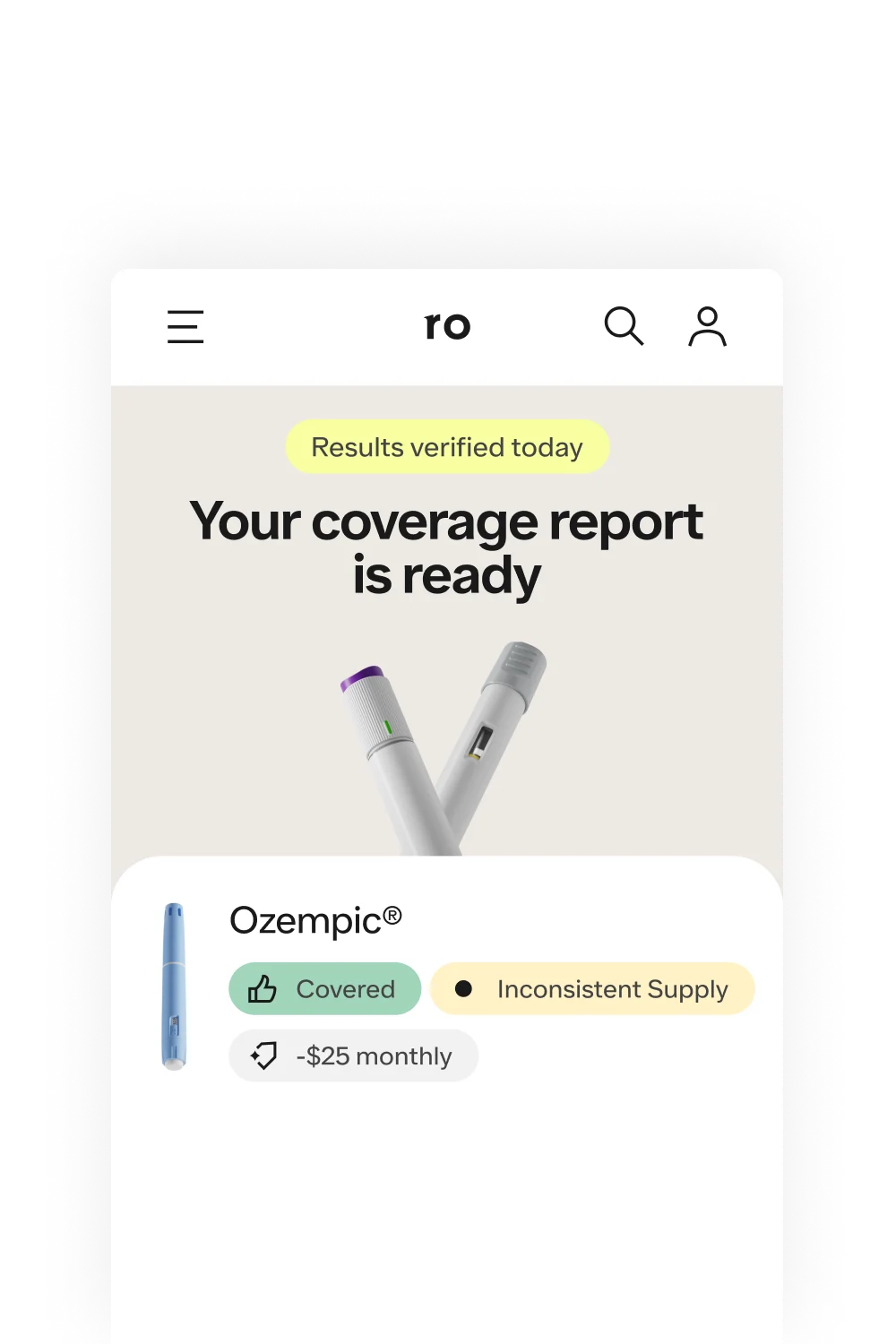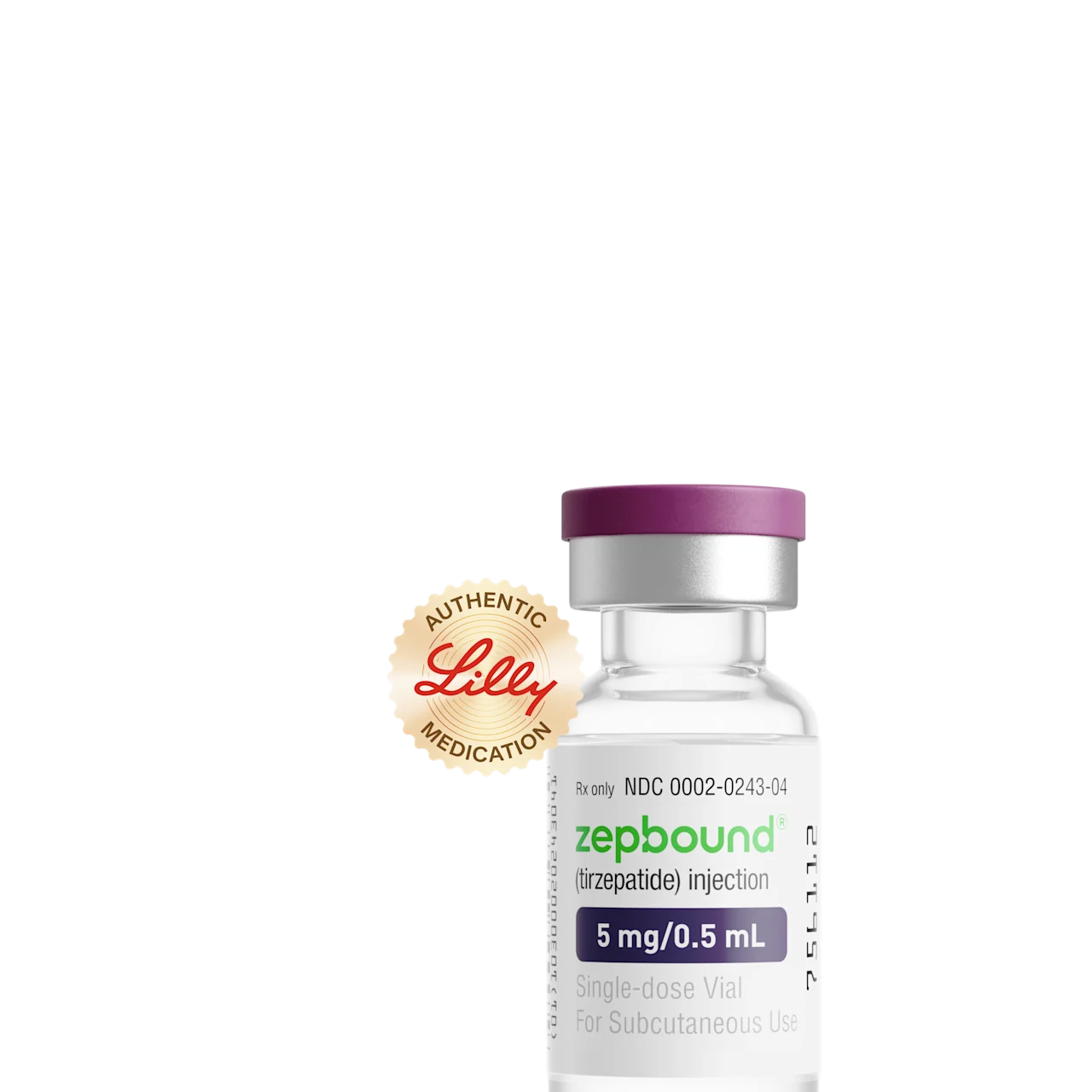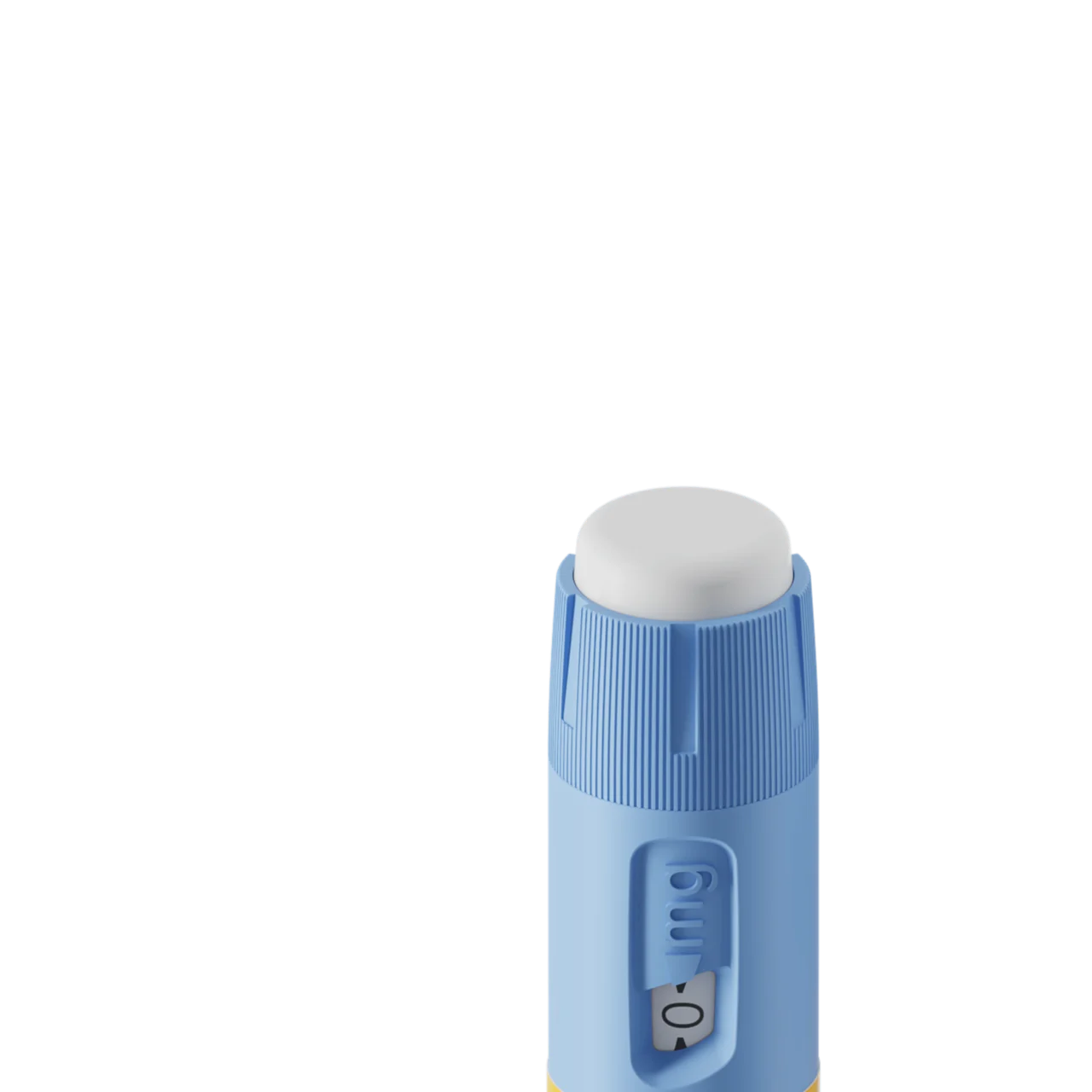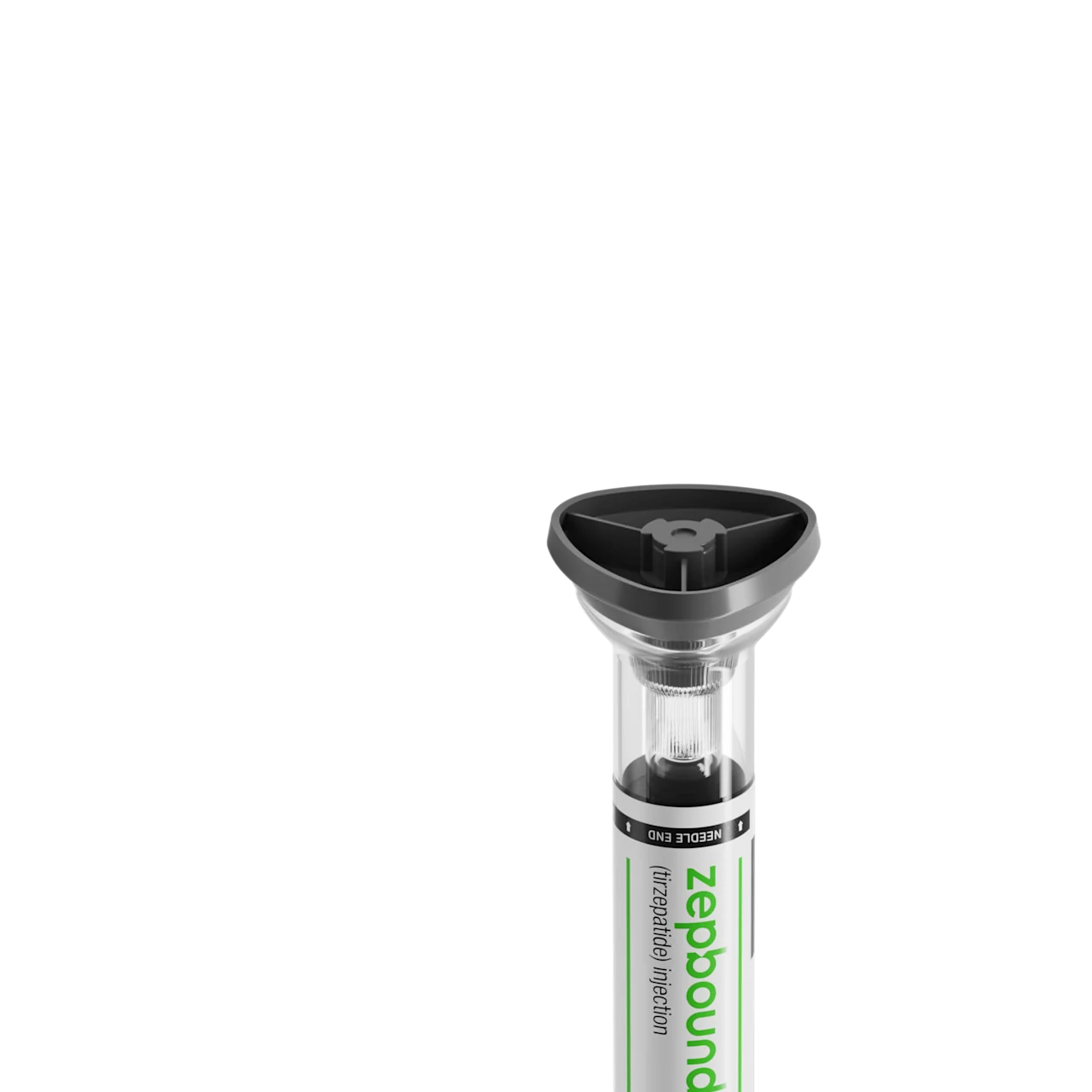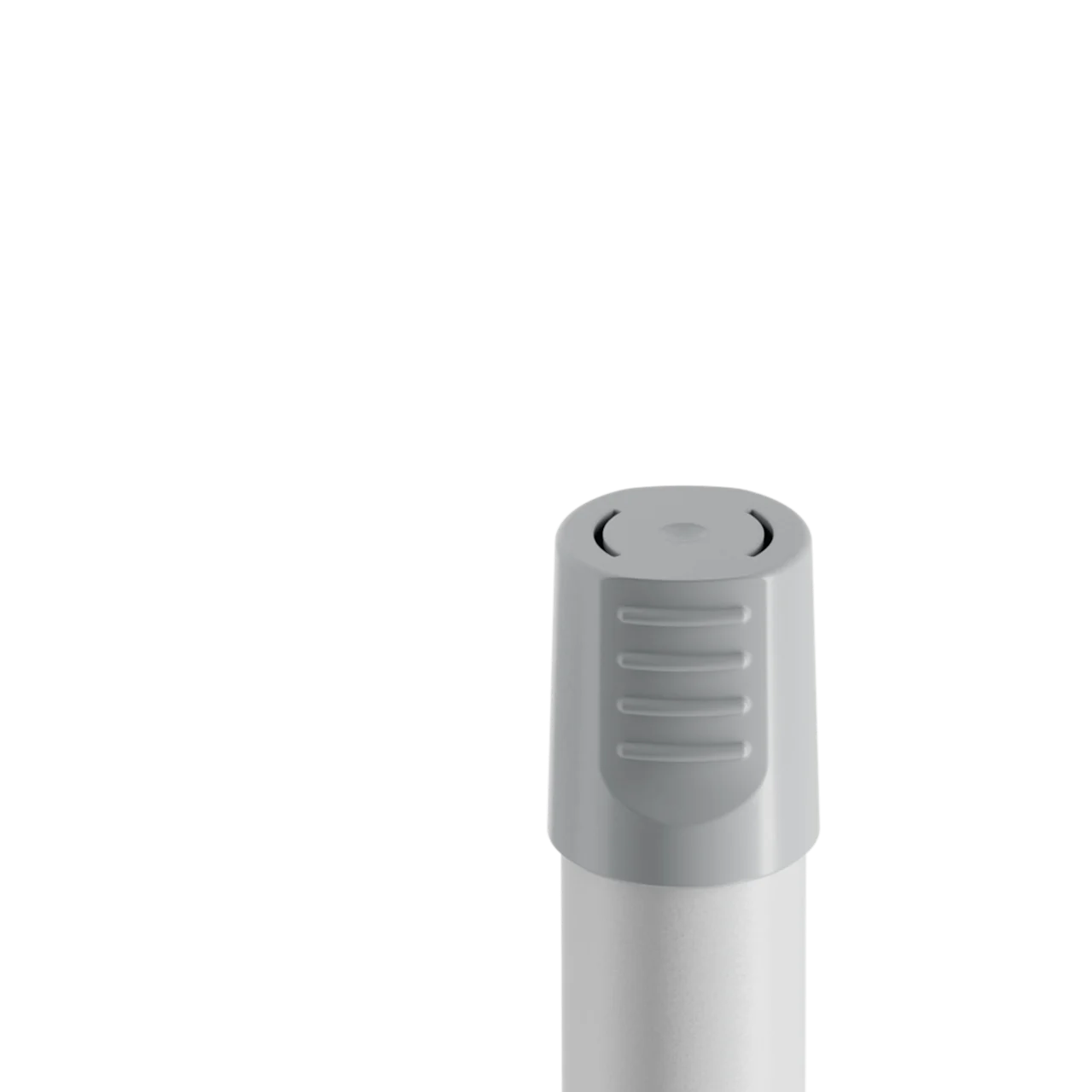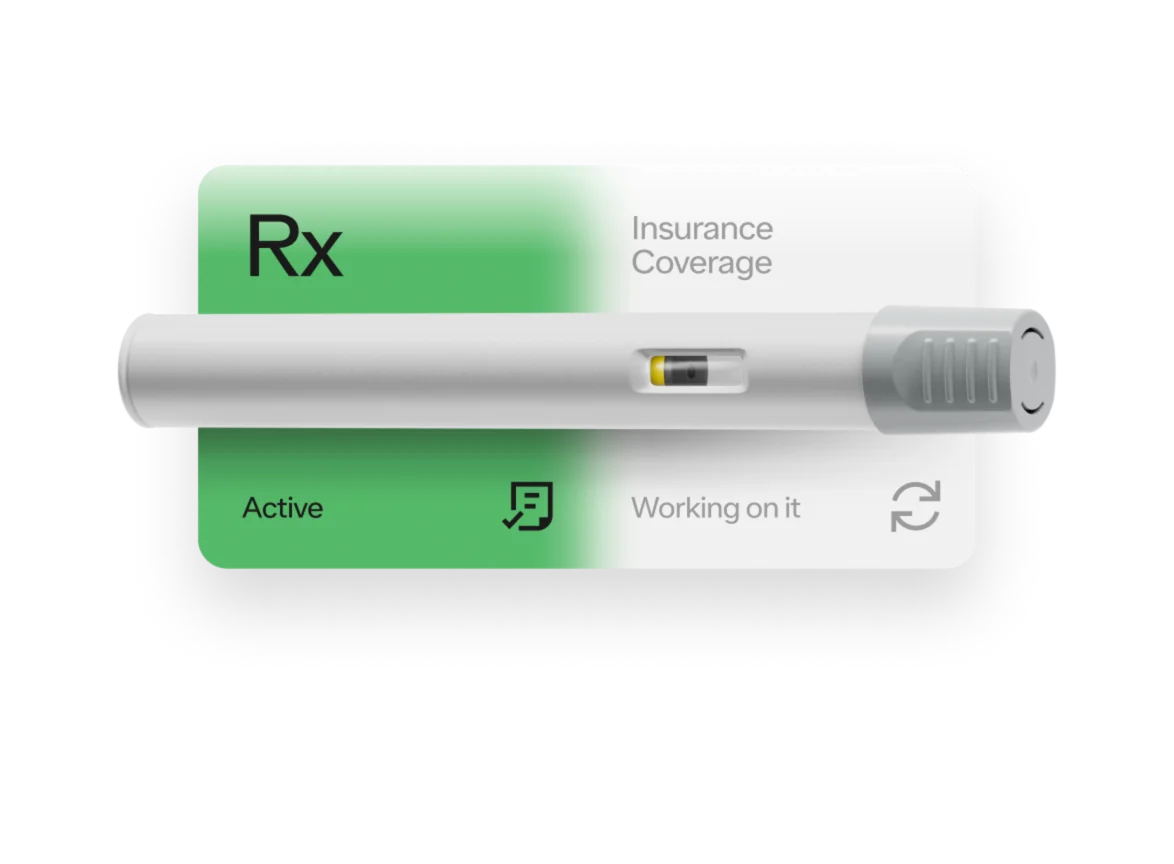Key takeaways
Zepbound (tirzepatide) and Ozempic (semaglutide) are injectable GLP-1 drugs. Zepbound is approved for weight loss. Ozempic is approved to treat type 2 diabetes but may be prescribed off-label for weight loss.
Both drugs can help promote weight loss by mimicking hormones that help to reduce hunger and increase feelings of fullness after eating.
While clinical trials haven’t compared Zepbound vs. Ozempic directly, available data for both drugs suggests that Zepbound may cause greater weight loss than Ozempic.
Common side effects of both drugs include nausea, diarrhea, and constipation.
Here's what we'll cover
Key takeaways
Zepbound (tirzepatide) and Ozempic (semaglutide) are injectable GLP-1 drugs. Zepbound is approved for weight loss. Ozempic is approved to treat type 2 diabetes but may be prescribed off-label for weight loss.
Both drugs can help promote weight loss by mimicking hormones that help to reduce hunger and increase feelings of fullness after eating.
While clinical trials haven’t compared Zepbound vs. Ozempic directly, available data for both drugs suggests that Zepbound may cause greater weight loss than Ozempic.
Common side effects of both drugs include nausea, diarrhea, and constipation.
Zepbound and Ozempic are both part of a drug class called glucagon-like peptide-1 receptor agonists, or GLP-1s. This breakthrough drug class has transformed diabetes treatment — and proven to be a highly effective tool for weight loss.
While they share some similarities, Zepbound and Ozempic are two different drugs with different indications and slightly different mechanisms of action. When it comes to weight loss, some research shows that tirzepatide (the active ingredient in Zepbound) is more effective and may help people lose 15% or more of their body weight.
If you’re curious whether Zepbound or Ozempic might be a good option, this article can help. Keep reading for an in-depth look at these two drugs to understand how they work, how they compare for weight loss, and other key differences.
What is Zepbound?
Zepbound (tirzepatide) is a dual glucose-dependent insulinotropic polypeptide (GIP) receptor and glucagon-like peptide-1 receptor agonist (GLP-1).
Tirzepatide is approved by the US Food and Drug Administration (FDA) to reduce weight in adults with:
Obesity
Overweight plus at least one weight-related condition, like type 2 diabetes, high blood pressure, or high cholesterol
Zepbound comes in a single-dose self-injectable pen that goes under the skin of your belly, thigh, or upper arm. It’s also available in a single-dose vial that you administer with a needle and syringe. Both the pen and vial come in 2.5 mg, 5 mg, 7.5 mg, 10 mg, 12.5 mg, and 15 mg doses.
The starting dose is 2.5 mg once a week. After four weeks, it increases to 5 mg a week. The dose then increases in 2.5 mg increments to achieve the desired weight loss, up to a maximum dose of 15 mg.
Tirzepatide is also available under the brand name Mounjaro, which is approved to treat type 2 diabetes.
What is Ozempic?
Ozempic (semaglutide)is a GLP-1 receptor agonist. It's FDA-approved to help regulate blood glucose (sugar) in people with type 2 diabetes. It also helps to reduce the risk of major heart events like heart attack and stroke in adults with type 2 diabetes and cardiovascular disease.
Some doctors may prescribe it off-label (for a condition it wasn't approved to treat) to help promote weight loss in people with obesity or overweight.
The Ozempic pen is a multi-dose pen that contains enough medication for one month. This means that each week, you attach a new needle to the pen and select your dose manually.
Ozempic is injected into the skin of the belly, thigh, or upper arm once a week. The injection pens come in 0.25 mg, 0.5 mg, 1 mg, and 2 mg strengths. The starting dose is 0.25 mg weekly for four weeks, increasing to 0.5 mg once a week.
Some people may stay at 0.5 mg as a maintenance dose. If you need additional support, your healthcare provider may continue to increase the dose every four weeks until you reach the maximum dose of 2 mg weekly.
Semaglutide is available under two other brand names: Wegovy and Rybelsus.
Wegovy is an injectable drug for weight loss.
Rybelsus is an oral medication for type 2 diabetes.
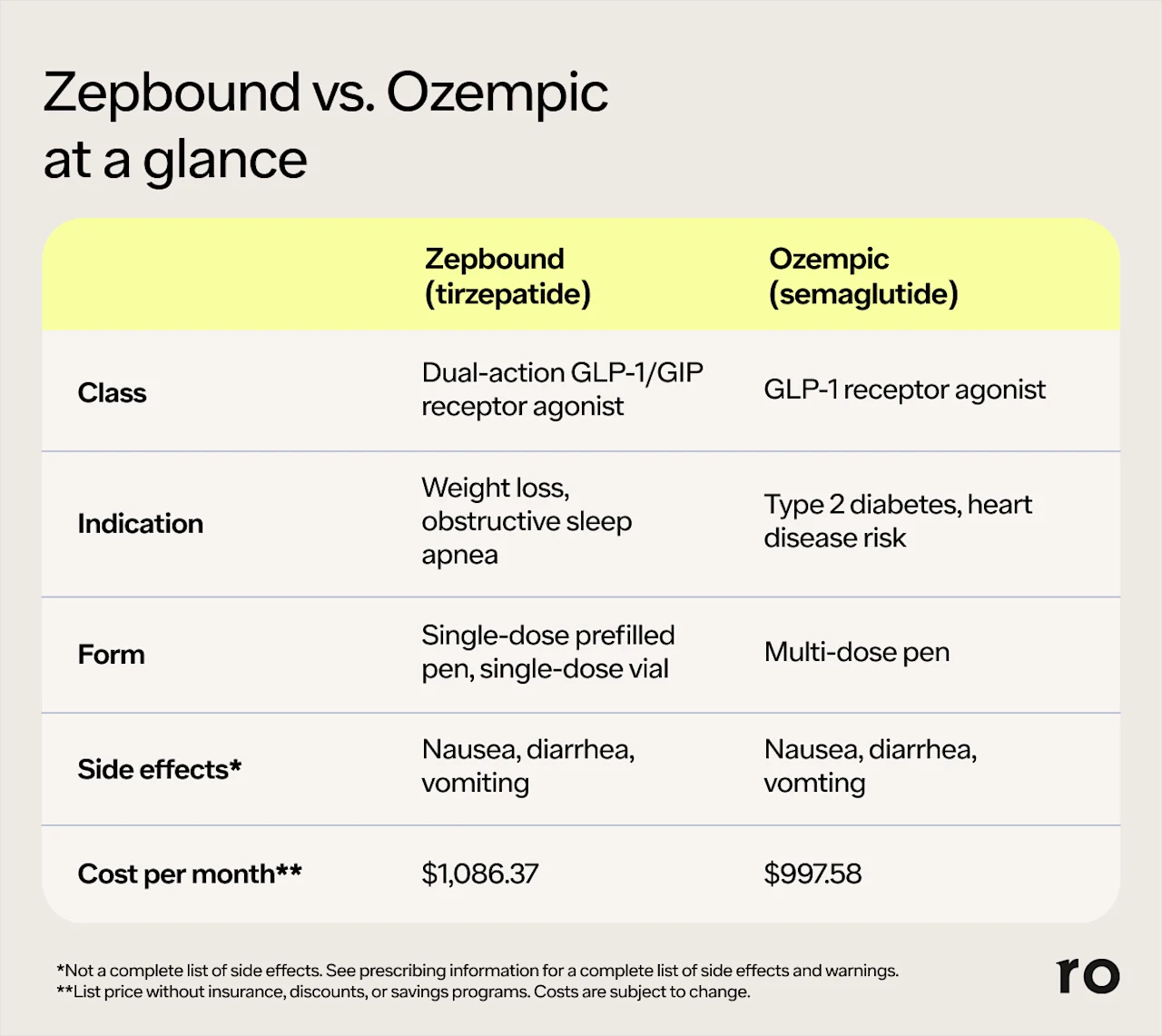
How do Zepbound and Ozempic work?
So, is Zepbound the same as Ozempic? Not quite. While the mechanisms of action for these drugs are similar, they each work in slightly different ways.
Both medications mimic GLP-1, a type of gut hormone that plays a role in regulating appetite, blood sugar, and satiety (how satisfied you feel after eating).
A key difference between the two drugs is that Zepbound is a dual receptor agonist that works on both GLP-1 and gastric inhibitory polypeptide (GIP). GIP is an incretin hormone that helps to regulate blood sugar levels and metabolism (how our bodies burn food for energy).
Zepbound and Ozempic bind to receptors for the GLP-1 hormone in your brain, stomach, and other parts of your body, which increases the amount of GLP-1 in your body.
This can promote weight loss in several ways:
GLP-1 stimulates the release of the hormone insulin from your pancreas, which can help move glucose (sugar) from your bloodstream into your cells to lower your blood sugar.
GLP-1 also reduces the release of glucagon, another hormone that raises your blood sugar. The net effect of these two actions is to improve blood sugar control.
GLP-1 also acts on receptors in your brain to reduce hunger cues, which can lower appetite and overall calorie intake.
When these medicines stimulate GLP-1 receptors in the stomach, they also slow gastric emptying, or how quickly food moves from your stomach to the lower intestine. Slower digestion can also help you to feel full faster, which may reduce the amount of food or calories you eat.
Studies have shown that the combination of GLP and GIP agonists can produce even more weight loss and better blood sugar control than a GLP-1 agonist alone.
These medications not only help people lose weight, but they also may improve cardiometabolic factors, which can potentially help lower the risk of heart disease and diabetes.
"There has never been a medication or class of medications that has worked for obesity in this way," says Christopher McGowan, MD, an obesity medicine specialist in Cary, North Carolina. "You can see these dramatic transformations, so that's gotten everyone's attention."
Zepbound vs. Ozempic weight loss results: how do they compare?
While both medications can be effective for weight loss, research suggests that Zepbound can potentially promote more significant weight loss, helping people lose up to 15%-20% or more of their body weight.

One observational study studied outcomes in more than 18,000 people with type 2 diabetes and obesity or overweight who were either taking tirzepatide or semaglutide.
Both medications helped most participants lose 5% or more of their body weight.
Those taking tirzepatide saw more significant weight loss, losing 15% or more of their body weight after 12 months of treatment.
Those taking semaglutide experienced 8.3% weight loss.
A 40-week clinical trial involving 1,800 participants compared type 2 diabetes treatment with tirzepatide and semaglutide and found similar results.
At 40 weeks, participants taking 15 mg weekly of tirzepatide (the maximum dose of Mounjaro and Zepbound) lost 11.2% of their body weight.
Those taking 1 mg of semaglutide lost 5.7% of their body weight in the same period.
Weight loss results are highly individual. The amount of weight you can lose on either Ozempic or Zepbound (or any other weight loss drug) varies and may be influenced by factors like starting weight, overall health, diet, exercise, and more.
Zepbound vs. Ozempic: 3 key differences to know
So, what is the difference between Zepbound and Ozempic? Here’s a quick recap of a few key distinctions between the drugs.
They have different indications
Zepbound is approved for weight loss. While Ozempic may sometimes be prescribed off-label for weight loss, it is only FDA-approved to treat type 2 diabetes.
They work in (slightly) different ways
Zepbound and Ozempic also have distinct active ingredients that work in slightly different ways — Ozempic targets GLP-1 receptors, while Zepbound targets both GLP-1 and GIP receptors.
They may produce different weight loss results
Both medications can be effective for regulating blood sugar and promoting weight loss. However, some research suggests that tirzepatide may lead to more weight loss than semaglutide.
Zepbound vs. Ozempic: side effects and risks
Zepbound and Ozempic went through an extensive clinical review and approval process and are considered generally safe medications.
The most common side effects of both drugs are gastrointestinal (GI) complaints, but dual agonists may lead to more of these side effects compared to single agonists.
In a review of two studies comparing tirzepatide and semaglutide, people who were treated with the 15 mg dose of Zepbound experienced more nausea and other GI side effects than those treated with a 1 mg dose of Ozempic.
These side effects may be more intense when you first start taking the medication (or when you move to the next dose) but tend to go away over time. In general, common side effects of both drugs are mild and manageable.
Side effects of Zepbound
Common Zepbound side effects may include:
Nausea
Upset stomach
Vomiting
Injection site reactions
Fatigue
Hair loss
Side effects of Ozempic
Some common side effects of Ozempic may include:
Vomiting
Abdominal pain
While on either of these drugs, you'll need regular monitoring to get the dose right. Your doctor will increase, or titrate, the dose until it's effective and monitor you for side effects. "Ideally, [patients] should be seen once a month," says Diala Alatassi, MD, an obesity medicine specialist at Endeavor Health in Elmhurst, Illinois.
Your healthcare provider can also recommend tips to help manage mild side effects. This might include eating smaller meals, drinking more water, or taking an anti-nausea medication.
Rare but serious risks of Zepbound and Ozempic
Both medications come with similar warnings and potential health complications, though these are rare. Regular monitoring by your healthcare provider can help minimize these risks.
Possible risks with Zepbound and Ozempic include:
Complications of the eye disease diabetic retinopathy in people with type 2 diabetes
Gallbladder disease
Low blood sugar (hypoglycemia)
Lung aspiration ( inhaling food or fluids into the lungs) during general anesthesia or deep sedation for a medical procedure
Severe allergic reactions like anaphylaxis
Kidney injury
Gallstones or inflammation of the gallbladder
Inflammation of the pancreas (pancreatitis)
Who should not take Zepbound or Ozempic?
"There are minimal contraindications for these medications," says Dr. Alatassi.
While Zepbound and Ozempic are generally safe, she adds that some people should not take these medications. You should not take either drug if you:
Are under the age of 18
Are pregnant, breastfeeding, or planning to become pregnant
Have kidney or liver disease
Have a known allergy to either medication
Additionally, both Zepbound and Ozempic carry a black box warning about an increased risk for thyroid C-cell tumors because these drugs caused thyroid tumors in rats in studies. Even though human studies have not shown the same effect, these drugs should not be used by people with a personal or family history of multiple endocrine neoplasia syndrome type 2 (MEN 2), a rare cancer that increases the risk for thyroid tumors.
Zepbound vs. Ozempic: costs and insurance coverage
Because many insurers view weight loss medications as non-essential, coverage can be limited. GLP-1s can cost up to $1,000 or more each month before insurance, savings cards, or other discounts.
Only one in five company health insurance plans cover the medications used mainly for weight loss, and most don’t cover medications used off-label. In some cases, people have to pay for these drugs out of pocket.
"That is the single greatest barrier to access — insurance coverage and cost," Dr. McGowan says.
Manufacturer savings cards, coupons, or direct-to-patient programs may help mitigate out-of-pocket costs.
How much does Zepbound cost?
Without insurance, Zepbound costs $1,086.37 for a month's supply.
If you have insurance that covers Zepbound, you could pay as little as $25 for a one- or three-month supply with the manufacturer savings card.
You can also get Zepbound at a reduced cost if you pay with cash. Through Ro, for example, you can get single-use vials of Zepbound at the following cash prices:
$299 per month: 2.5 mg dose
$399 per month: 5 mg dose
$449 per month (with manufacturer offer): 7.5 mg, 10 mg, 12.5 mg, 15 mg doses
Some drug discount sites may also offer pharmacy-specific coupons for Zepbound.
How much does Ozempic cost?
Ozempic costs an average of $997.58 per month.
If you have insurance coverage, you could pay just $25 for a one- to three-month supply for up to 24 months with a manufacturer savings card.
If you’re paying out of pocket, you may also be able to find Ozempic coupons from popular drug discount sites.
Zepbound vs. Ozempic: lifestyle recommendations and long-term use
As effective as they may be, weight-loss drugs like Ozempic or Zepbound aren’t a quick fix. To get — and maintain — your weight loss results or blood sugar control, you may need to stick with the medication long-term.
"You have to plan to stay on it forever," says Dr. McGowan. "Once you discontinue a GLP-1 medication, you will regain the weight."
A healthy diet and regular exercise are important for everyone, and the same is true when you’re taking a GLP-1. These medications are designed to be combined with a balanced diet and regular exercise to achieve optimal results and support healthy habits. These lifestyle interventions may also help reduce rebound weight gain if you do stop taking a GLP-1 medication.
While there isn't a specific diet you need to follow, you should aim to meet the government's dietary guidelines, Dr. Alatassi says.
She adds that people taking weight loss medications should be sure to get enough protein.
"Usually, we start with at least 1 gram for every kilogram of weight in protein daily because protein is very important for building and maintaining muscle mass, which is a risk that we get concerned about when patients lose weight rapidly," Dr. Alatassi says.
Find your recommended protein intake
Calculate your recommended daily protein needs for weight loss, maintaining weight, or building muscle, based on your current weight and activity level.
Recommended protein intake
0 – 0
Grams/Day
0 – 0
Grams/Meal
This calculator provides general estimates and should not replace professional medical advice. Always consult a healthcare provider or registered dietitian before making significant changes to your diet or nutrition plan.
When it comes to movement, any kind of exercise is beneficial. Strength training, light cardio like walking or jogging, and high-intensity interval training (HIIT) may be especially helpful for weight loss by helping you burn more calories and build muscle.
Questions for your healthcare provider
Curious about taking Zepbound or Ozempic for weight loss? Talk to your healthcare provider. They can evaluate whether you’re a good candidate for either medication based on your goals, health status, and personal and family health history.
Here are a few questions the experts interviewed with suggest you ask before getting a prescription for weight loss medication:
Which weight loss injection is most appropriate for me?
How much weight can I expect to lose on the medicine?
Will my health insurance cover the cost?
How might this medication interact with other drugs I take?
What are the possible side effects?
How do I manage side effects if I have them?
How will you monitor me while I'm on the medicine?
What dietary changes should I make while taking the medicine?
Rx weight loss with Ro
Get access to prescription weight loss medication online
Bottom line
Zepbound and Ozempic are effective medications for weight loss and blood sugar control. While they work in similar ways, there are a few key differences that could impact whether these medications are a good option for you. Your healthcare provider can help determine which is best based on your health needs and goals.
Zepbound and Ozempic are two different medications with different indications. Zepbound (tirzepatide) is approved for weight loss, while Ozempic (semaglutide) is approved for type 2 diabetes, though in some cases it may be prescribed off-label for weight loss.
Both Zepbound and Ozempic boost levels of the GLP-1 hormone, which helps to reduce appetite, make you feel full faster, and improve blood sugar control. Zepbound also targets GIP, a hormone that helps to regulate blood sugar levels and metabolism.
Research suggests that Zepbound (tirzepatide) produces more significant weight loss than Ozempic (semaglutide). In one clinical trial, participants lost 11.2% of their body weight with 15 mg of tirzepatide, compared to 5.7% of weight with 1 mg of semaglutide.
Both drugs have similar side effects. The most common are GI issues like nausea, vomiting, and constipation. Common side effects tend to be mild and go away the longer you are on the medication. Some research suggests that dual-agonist drugs like Zepbound may cause more GI side effects at higher dose strengths.
These drugs are meant to be taken long-term. Stopping them too soon may make you regain the weight you lost.
Both medications can cost up to $1,000 or more each month, and most insurance providers don’t cover weight loss medications. Savings programs, coupons, and other discounts may help offset these costs.
Talk to your healthcare provider about any questions or concerns you might have. They can evaluate your personal and family health history, overall health, and other factors to help you find the right treatment plan to reach your goals.
Frequently asked questions (FAQs)
Is Ozempic or Zepbound better for weight loss?
Evidence suggests that Zepbound may be better for weight loss. In a clinical trial, the average weight loss with tirzepatide (the active ingredient in Zepbound) was 11.2% compared with 5.7% with Ozempic.
What is comparable to Zepbound?
Mounjaro is the other version of tirzepatide. It's FDA-approved to improve blood sugar control in adults with type 2 diabetes.
What is the average weight loss on Zepbound?
In one clinical trial studying tirzepatide in adults with obesity, or overweight plus at least one weight-related condition, the average weight loss after 72 weeks was 15% on the 5 mg weekly dose, 19.5% with the 10 mg dose, and 20.9% with the 15 mg dose.
Can you switch from Ozempic to Zepbound?
Is there a better alternative to Ozempic?
There are several alternatives to Ozempic for type 2 diabetes, including Trulicity, Mounjaro, and other diabetes drugs. Alternative medications for weight loss include Wegovy, Saxenda, Zepbound, or oral medications.
DISCLAIMER
If you have any medical questions or concerns, please talk to your healthcare provider. The articles on Health Guide are underpinned by peer-reviewed research and information drawn from medical societies and governmental agencies. However, they are not a substitute for professional medical advice, diagnosis, or treatment.
Zepbound Important Safety Information: Read more about serious warnings and safety info.
Ozempic Important Safety Information: Read more about serious warnings and safety info.
GLP-1 Important Safety Information: Read more about serious warnings and safety info.
Mounjaro Important Safety Information: Read more about serious warnings and safety info.
Wegovy Important Safety Information: Read more about serious warnings and safety info.
Saxenda Important Safety Information: Read more about serious warnings and safety info.
References
American Society of Health-System Pharmacists. (2024). Semaglutide Injection. Retrieved from https://www.ashp.org/drug-shortages/current-shortages/drug-shortage-detail.aspx?id=813
Frías, J. P., Davies, M. J., Rosenstock, J., et al. (2021). Tirzepatide versus Semaglutide Once Weekly in Patients with Type 2 Diabetes. The New England Journal of Medicine, 385(6), 503–515. doi: 10.1056/NEJMoa2107519. Retrieved from https://www.nejm.org/doi/full/10.1056/NEJMoa2107519
Han, S. H., Safeek, R., Ockerman, K., et al. (2023). Public Interest in the Off-Label Use of Glucagon-like Peptide 1 Agonists (Ozempic) for Cosmetic Weight Loss: A Google Trends Analysis. Anesthetic Surgery Journal, 44(1), 60-67. doi: 10.1093/asj/sjad211. Retrieved from https://pubmed.ncbi.nlm.nih.gov/37402640/
Hinnen, D. (2017). Glucagon-Like Peptide 1 Receptor Agonists for Type 2 Diabetes. Diabetes Spectrum, 30(3), 202-210. doi: 10.2337/ds16-0026. Retrieved from https://pmc.ncbi.nlm.nih.gov/articles/PMC5556578/
Jastreboff, A. M., Aronne, L. J., Ahmad, N. N., et al. (2022). Tirzepatide Once Weekly for the Treatment of Obesity. The New England Journal of Medicine, 387(3), 205-216. doi: 10.1056/NEJMoa2206038. Retrieved from https://pubmed.ncbi.nlm.nih.gov/35658024/
Jensterle, M., Rizzo, M., Haluzik, M., et al. (2022). Efficacy of GLP-1 RA Approved for Weight Management in Patients With or Without Diabetes: A Narrative Review. Advances in Therapy, 39(6), 2452-2467. doi: 10.1007/s12325-022-02153-x. Retrieved from https://pmc.ncbi.nlm.nih.gov/articles/PMC9063254/
KFF. (2024). 2024 Employer Health Benefits Survey. Retrieved from https://www.kff.org/report-section/ehbs-2024-summary-of-findings/
Kosiborod, M. N., Bhatta, M., Davies, M., et al. (2022). Semaglutide Improves Cardiometabolic Risk Factors in Adults with Overweight or Obesity: STEP 1 and 4 Exploratory Analyses. Diabetes, Obesity and Metabolism, 25(2), 468-478.doi: 10.1111/dom.14890. Retrieved from https://pmc.ncbi.nlm.nih.gov/articles/PMC10092593/
Lilly-a. (2024). Highlights of Prescribing Information for Zepbound. Retrieved from https://pi.lilly.com/us/zepbound-uspi.pdf
Lilly. (n.d.). How much should I expect to pay for Zepbound (tirzepatide)? Retrieved from https://pricinginfo.lilly.com/zepbound
Marso, S. P., Bain, S. C., Consoli, A., et al. (2016). Semaglutide and Cardiovascular Outcomes in Patients with Type 2 Diabetes. The New England Journal of Medicine, 375(19), 1834–1844. doi: 10.1056/NEJMoa1607141. Retrieved from https://www.nejm.org/doi/full/10.1056/nejmoa1607141
Nauck, M.A. & D'Alessio, D.A. (2022). Tirzepatide, a dual GIP/GLP-1 Receptor Co-Agonist for the Treatment of Type 2 Diabetes with Unmatched Effectiveness Regarding Glycaemic Control and Body Weight Reduction. Cardiovascular Diabetology, 169. doi: 10.1186/s12933-022-01604-7. Retrieved from https://cardiab.biomedcentral.com/articles/10.1186/s12933-022-01604-7
Neeland, I. J., Linge, J., Birkenfeld, A. L. (2024). Changes in Lean Body Mass with Glucagon-Like Peptide-1-Based Therapies and Mitigation Strategies. Diabetes, Obesity, and Metabolism, 26(S4), 16-27. https://doi.org/10.1111/dom.15728. Retrieved from https://dom-pubs.onlinelibrary.wiley.com/doi/full/10.1111/dom.15728
Novo Nordisk. (2024). Highlights of Prescribing Information for Ozempic. Retrieved from https://www.ozempic.com/prescribing-information.html
Novo Nordisk-a. (n.d.). Ozempic. Retrieved from https://www.novopricing.com/ozempic.html
Novo Nordisk-b. (n.d.). Using your Ozempic pen. Retrieved from https://www.ozempic.com/how-to-take/ozempic-pen.html
Rodriguez, P. J., Goodwin Cartwright, B. M., Gratzl, S., et al. (2024). Semaglutide vs Tirzepatide for Weight Loss in Adults with Overweight or Obesity. JAMA Internal Medicine, 184(9), 1056-1064. doi: 10.1001/jamainternmed.2024.2525. Retrieved from https://pmc.ncbi.nlm.nih.gov/articles/PMC11231910/
U.S. Food & Drug Administration (FDA). (2023). FDA Approves New Medication for Chronic Weight Management. Retrieved from https://www.fda.gov/news-events/press-announcements/fda-approves-new-medication-chronic-weight-management
U.S. Food & Drug Administration (FDA-a). (2024). FDA Clarifies Policies for Compounders as National GLP-1 Supply Begins to Stabilize. Retrieved from https://www.fda.gov/drugs/drug-safety-and-availability/fda-clarifies-policies-compounders-national-glp-1-supply-begins-stabilize
U.S. Food & Drug Administration (FDA-a). (2025). Highlights of Prescribing Information: Mounjaro (tirzepatide) Injection, for subcutaneous use. Retrieved from https://www.accessdata.fda.gov/drugsatfda_docs/label/2025/217806s031lbl.pdf
U.S. Food & Drug Administration (FDA-b). (2025). Highlights of Prescribing Information: Ozempic (semaglutide) injection, for subcutaneous use. Retrieved from https://www.accessdata.fda.gov/drugsatfda_docs/label/2025/209637s035,209637s037lbl.pdf
U.S. Food & Drug Administration (FDA-c). (2025). Highlights of Prescribing Information: Zepbound (tirzepatide) Injection, for subcutaneous use. Retrieved from https://www.accessdata.fda.gov/drugsatfda_docs/label/2025/217806s031lbl.pdf



